Cats and lettuce may not look like a match made in heaven. We all know that cats are carnivores and thrive on meat. Yet, some cats show interest in greenery, such as lettuce. If your cat is one of them, you are probably asking yourself, ‘Can cats eat lettuce?’
Lettuce nutritional value
Lettuce is a staple food for health-conscious people. It is hearty food, even if it contains just a few calories. Its pleasant yet neutral taste makes it a favorite of many vegetarians and not only.
Lettuce contains about eight calories per cup, which makes it perfect for weight loss diets.
What nutritious substances do you get by eating lettuce?
- Vitamin C which supports the immune system;
- Calcium which is vital for the health of bones, muscles, and nerves;
- Vitamin K helps with blood clotting. In combination with calcium, it prevents mineral loss and the onset of osteoporosis;
- Vitamin A, a powerful antioxidant that supports eye health, cell growth, and the reproductive system;
- Vitamin B, vital for DNA production and cell division;
- Potassium, an electrolyte that enables your heart to beat regularly and your nerves to function correctly;
- Magnesium, a muscle relaxant and aid for enzyme function;
- Phosphorous, a mineral ensuring strong bones and teeth together with calcium.
Different types of lettuce
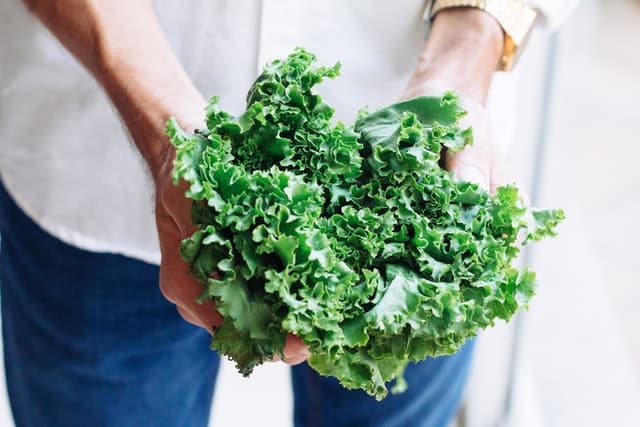
There are at least ten common types of lettuce, with different colors and leaf shapes. All varieties belong to the Lactuca sativa species and are rich in water, fiber, and nutrients. The most popular lettuce types are:
- Batavia lettuce
Also known as summer crisp or French crisp, this lettuce variety does not wilt fast and is crunchier than other types. It is easy to recognize by its crinkled, wavy laves.
- Romaine lettuce
Romaine lettuce has long, slightly bitter leaves, but its center is sweet and solid. It is usually used in Caesar salads.
- Bibb lettuce
Bibb lettuce’s small bundles are about the size of a fist and are preferred for their sweeter taste.
- Boston lettuce
A type of butter lettuce like Bibb lettuce, Boston lettuce is bigger than its relative and wilts more easily.
- Iceberg lettuce
Iceberg lettuce is the most popular type in the United States and contains the highest percentage of water.
- Leaf lettuce
All lettuce varieties have leaves, but the leaves of this variety come in multiple green and red shades.
- Lamb’s lettuce
Lamb lettuce has smaller, dark leaves that come in clusters of four or five.
- Red leaf lettuce
This variety has red, crinkled leaves and includes cultivars such as ‘Lollo Rossa’ and ‘Red Sails Lettuce’.
Is it OK to give cats lettuce?
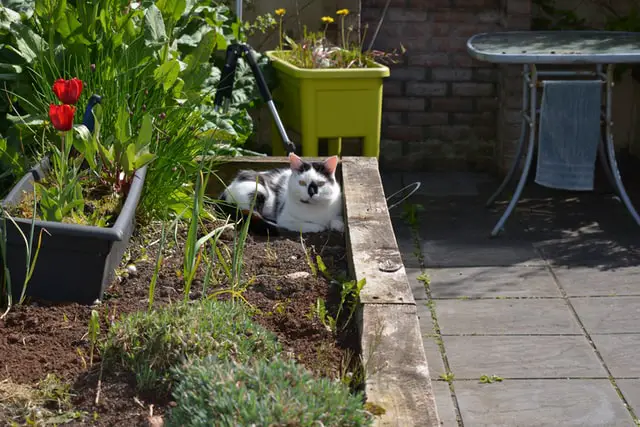
With so many lettuce varieties out there, you are probably asking, ‘Can cats eat lettuce?’ And ‘Is it OK to give cats lettuce?’
The quick answer is yes; cats can eat lettuce.
It is perfectly safe for felines as a treat, and it can even provide some benefits.
There are multiple reasons to offer your cat lettuce:
- Preventing your cat from eating houseplants;
- Adding fiber to your cat’s diet;
- Offering a snack that doesn’t cause weight gain.
How much greenery can cats eat?
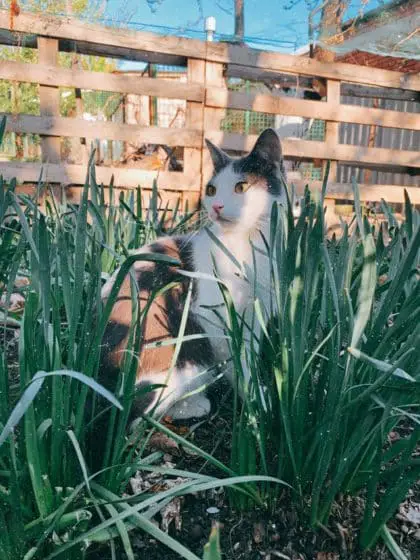
Can cats eat lettuce? Yes, but not just lettuce! A cat will never eat only greens.[1]
Felines are obligate carnivores and cannot survive without meat.
Even if you are a convinced vegetarian, you shouldn’t try to make your cat a vegetarian too. A cat that doesn’t eat meat will die.
While feeding your cat lettuce is perfectly safe, you must not feed your cat lettuce only. Cats cannot get the nutrients they need from plant-based foods. Their biology makes it impossible. Your cat’s life and health depend on animal-based foods.
What greens can cats eat?
Even if you don’t offer your cat greenery, it may experiment with it. Many cats are known to nibble on grass. Others will attack your houseplants, which is bad for your plants.
It can also be bad for the kitty because some houseplants are toxic. [2]
Can cats eat lettuce? Yes, and other plants as well. [3]
Here are the safest and most beneficial plants your cat can eat:
- Bee balm
- Catmint
- Catnip
- Chamomile
- Chervil
- Dill
- Hyssop
- Lavender
- Lemon balm
- Licorice root
- Dandelion root
- Verbena
- Lovage
- Peppermint
- Oregano
- Parsley
- Rosemary
- Sage
- Thyme
Why some cats like eating plants?
Cats eat plants for multiple reasons:
- To help to remove non-digestible items like fur;
- Get relief from constipation due to the high content of fiber;
- Obtain nutrients such as folic acid, necessary for DNA production and maintaining blood oxygen levels within the optimal range;
- According to a hypothesis, to help them get rid of intestinal parasites such as worms. Greenery would physically scrub the walls of the gut and remove parasites;
- To have fun or to satisfy their curiosity.
Does your cat need lettuce?
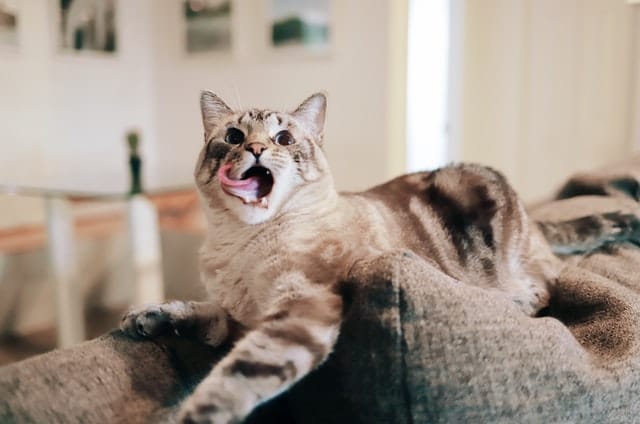
Your can will be perfectly fine without lettuce. However, it does need a certain amount of greenery.
Lettuce is a good choice because it is harmless and accessible in most parts of the world.
If your cat’s food is of excellent quality, you can skip greenery. However, you cannot be sure that commercial food meets all the cat’s nutritional demands. The kitty will certainly not suffer by trying some lettuce or another safe plant.
It may even have some fun during the process!
Benefits of feeding lettuce as a snack
Have you decided to offer your cat lettuce? It is an excellent idea. Lettuce will provide the following benefits to your kitty:
- Supporting its weight loss plan
If your cat struggles to keep a healthy weight, snacks like lettuce will enable you to attain your goals.
One trick to prevent overfeeding is measuring out the food you want to offer your cat for the entire day. Even if the cat east multiple times a day, it will not exceed the limit. This method is easier than measuring out every meal separately.
- Complements dry food
Cats eating dry food only may have trouble staying hydrated. Lettuce can help as it contains approximately 95% water. Make sure your cat drinks enough water to prevent urinary tract infections.
- Preventing constipation
Having a sufficient amount of fiber in your diet helps you ‘go’ regularly. The same happens with pets. Lettuce will provide that amount of fiber needed to have regular bowel movements.
- Lettuce is packed with vitamins and nutrients
Not just humans need vitamins from plants in their diet but kitties too. Eating quality food can be sufficient, but a healthy snack certainly doesn’t hurt.
- Stimulating the cat
Experimenting with plants can keep your cat entertained while also getting some vital nutrients.
Some plants, such as catnip, can give them a drug-like euphoria. Snacking on lettuce is preferable to having your houseplants nibbled on.
- Adding variety to their diet
Cats need variety in their diet, just like people. Sometimes they can try things that are not edible. Lettuce, on the other hand, is perfectly safe to experiment with.
How can you make lettuce more attractive to cats?
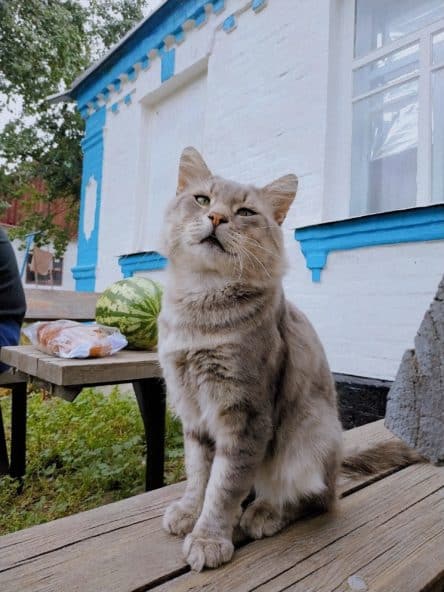
Can cats eat lettuce? Yes.
Will they voluntarily eat it? Not all the time.
There are several tricks you can try to determine your cat to have lettuce or another healthy snack:
- Cutting lettuce into smaller pieces
Cats are notoriously picky eaters and may want to have food presented to them in a certain way. Giving large pieces of lettuce can result in a firm refusal. To make lettuce or greenery more appealing, cut it into small pieces or strips.
- Try multiple times
Cats often refuse new things. Consider offering greenery repeatedly before giving up.
- Try different varieties
Cats can refuse one type of lettuce for no apparent reason and love a variety with smaller or smoother leaves. Some pet owners have observed that their cats like varieties with darker leaves.
- Try different parts of the plant
Some kitties will prefer the leaves, while others may show more interest in the core.
- Put lettuce next to the cat’s food
Lettuce can be a weird object to your cat and not make it think about food at all. Placing a small piece of lettuce next to its food bowl can make the cat accept it.
What greenery is toxic to cats
Not all plants are safe for cats. Some are poisonous.
What foods are toxic to cats? Look out for these common yet harmful plants:
- Azaleas and rhododendrons
There are more than 1,000 species in this family of plants with different toxicity levels. The toxin contained by rhododendrons is called grayanotoxin.
- Autumn crocus
The meadow saffron blooms in the fall and is toxic to cats, dogs, and horses. All parts of the plant are very toxic due to their alkaloid colchicine content.
- Daffodils
Daffodils contain lycorine, with their bulbs being the most toxic part of the plant.
- Cyclamen
These indoor plants contain saponins concentrated in their tubers and roots.
- Kalanchoe
Also known as the mother-in-law plant of devil’s backbone, kalanchoe contains bufadienolides, which cause gastrointestinal issues.
Other dangerous plants are tulips, hyacinth, sago palm, oleander, lilies, and dieffenbachia. If you suspect your cat has ingested a toxic plant, contact your vet.
Conclusion
Can cats eat lettuce? Yes.
Lettuce is not a compulsory part of a cat’s diet, but it doesn’t do any harm. In small quantities, it can provide the cat vitamins and mental stimulation. Your kitty should try it too!
